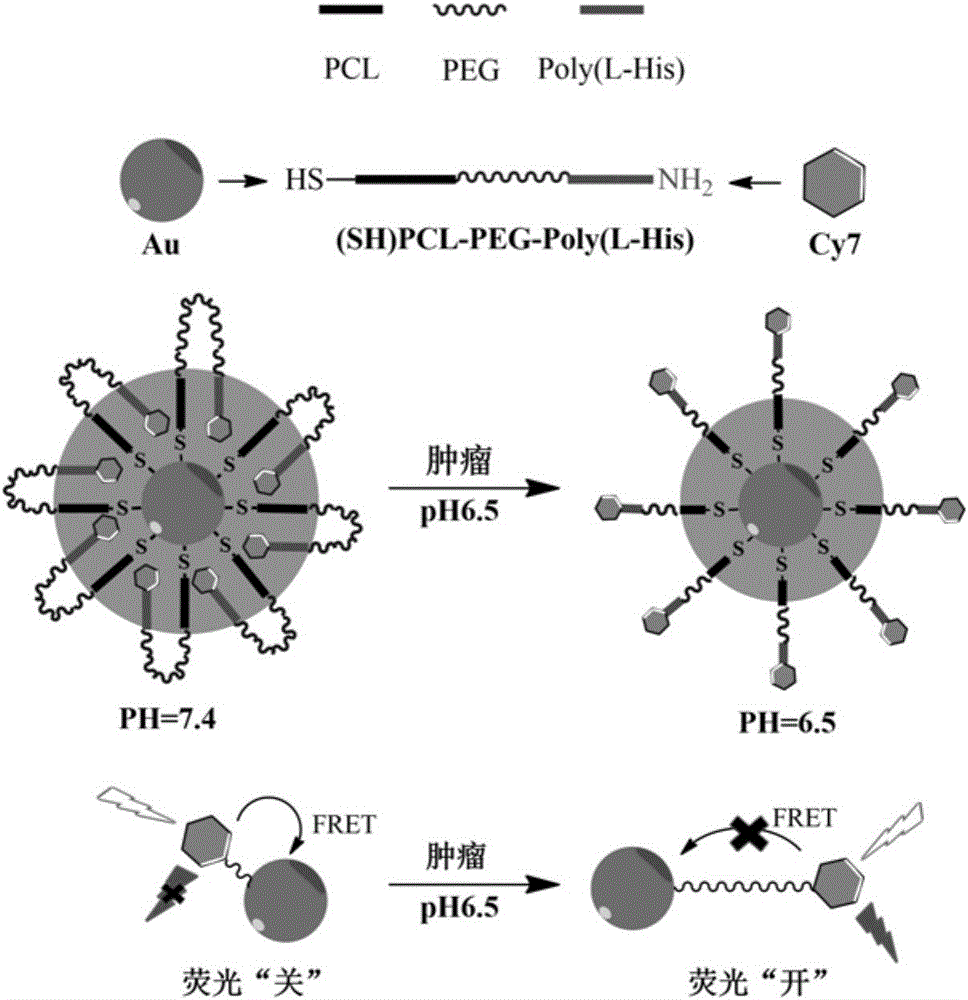PH-sensitive block polymer, FRET (fluorescence resonance energy transfer) composite and their preparation methods
A block polymer, polymer technology, applied in the FRET complex model and its preparation, the field of pH-sensitive block polymer, can solve the problem of inability to realize the integration of diagnosis and treatment in vivo and so on
- Summary
- Abstract
- Description
- Claims
- Application Information
AI Technical Summary
Problems solved by technology
Method used
Image
Examples
preparation example Construction
[0048] The preparation method of gold nanorods is as follows:
[0049] Synthetic gold species: 5mL 0.2mol / L CTAB (cetyltrimethylammonium bromide) mixed with 5mL 0.5mmol / L chloroauric acid, and then add 0.6mL 0.01mol / L of sodium borohydride, vigorously stirred for 5 minutes, and allowed to stand at room temperature for 2 hours, used as seed gold nanoparticles;
[0050] Synthesis of short gold nanorods by CTAB template method: take seven 25mL sample vials (marked as GNP-A1, GNP-A2, GNP-A3, GNP-A4, GNP-A5, GNP-A6, GNP-A7), Add 5mL 0.2mol / L CTAB aqueous solution respectively, and add different amounts of 4mmol / L AgNO 3 Aqueous solution (0.050, 0.10, 0.15, 0.20, 0.25, 0.30 and 0.40mL), then add 5mL of 1mmol / L chloroauric acid aqueous solution, at this time the color of the solution turns golden yellow, then add 70μL of 0.0788mol / L ascorbic acid , the solution becomes colorless instantly. Finally, 12 μL of seed gold nanoparticle dispersion was added respectively, and left to rea...
Embodiment 1
[0053] The preparation method of a kind of pH-sensitive block polymer of this embodiment (preparation process is as follows image 3 shown) as follows:
[0054] Use 1g of 2kDa Fmoc-NH-PEG-OH, 1.2g of caprolactone, and react under vacuum and nitrogen protection conditions at 130°C for 6 hours to synthesize Fmoc-NH-PEG-PCL (polymer of 2000-2000) through anhydrous ether Precipitate, dialyze and lyophilize;
[0055] Weigh 0.3mmol Fmoc-NH-PEG-PCL, 0.45mmol lipoic acid, 0.45mmol dicyclohexylcarbodiimide, 0.45mmol 4-dimethylaminopyridine, 0.3mL triethylamine and 0.3mL pyridine and add 30mL DMSO , react for 48 hours to prepare Fmoc-NH-PEG-PCL-LA;
[0056] Use 20% piperidine in dimethylformamide solution to remove the protective group at the amino terminal, that is, stir at 25°C for 10 minutes, and precipitate with anhydrous ether to prepare NH-PEG-PCL-LA;
[0057] Then the exposed amino group is used for ring-opening histidine anhydride, that is, using NH-PEG-PCL-LA ring-opening po...
Embodiment 2
[0061] The preparation method of a kind of pH-sensitive block polymer of the present embodiment is as follows:
[0062] Use 5kDa Fmoc-NH-PEG-OH to open ring caprolactone to a hydrophobic chain length of 10000Da to synthesize NH 2 -PEG-PCL (a polymer of 5000-10000);
[0063] 1g of 5kDa Fmoc-NH-PEG-OH, 3g of caprolactone, reacted at 170°C under vacuum and nitrogen protection for 6 hours to synthesize Fmoc-NH-PEG-PCL, precipitated with anhydrous ether, dialyzed and freeze-dried;
[0064] Weigh 0.3mmol Fmoc-NH-PEG-PCL, 0.45mmol lipoic acid, 0.45mmol dicyclohexylcarbodiimide, 0.45mmol 4-dimethylaminopyridine, 0.3mL triethylamine and 0.3mL pyridine and add 30mL DMSO In the solution, react for 48 hours to prepare Fmoc-NH-PEG-PCL-LA;
[0065] Use 20% piperidine in dimethylformamide solution to remove the protective group at the amino terminal, that is, stir at 25°C for 20 minutes, and precipitate with anhydrous ether to prepare NH-PEG-PCL-LA;
[0066] Then the exposed amino group i...
PUM
 Login to View More
Login to View More Abstract
Description
Claims
Application Information
 Login to View More
Login to View More - R&D
- Intellectual Property
- Life Sciences
- Materials
- Tech Scout
- Unparalleled Data Quality
- Higher Quality Content
- 60% Fewer Hallucinations
Browse by: Latest US Patents, China's latest patents, Technical Efficacy Thesaurus, Application Domain, Technology Topic, Popular Technical Reports.
© 2025 PatSnap. All rights reserved.Legal|Privacy policy|Modern Slavery Act Transparency Statement|Sitemap|About US| Contact US: help@patsnap.com



